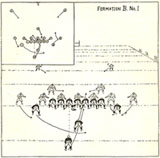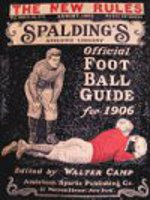While reviewing something from the 1911 Carlisle Indian School football season, a pair of sentences on the front page of the November 3rd edition of The Carlisle Arrow caught my eye. The paragraph began with: “The new guard-house is about finished.” That the Hessian powder magazine, built in 1777 by prisoners captured by Washington in the Battle of Trenton, wasn’t always used to incarcerate recalcitrant students. This was news to me. That students and their instructors provided the labor was not surprising because they had build other buildings, including Pop Warner’s house and the Native Arts Building, both of which still stand.
While reviewing something from the 1911 Carlisle Indian School football season, a pair of sentences on the front page of the November 3rd edition of The Carlisle Arrow caught my eye. The paragraph began with: “The new guard-house is about finished.” That the Hessian powder magazine, built in 1777 by prisoners captured by Washington in the Battle of Trenton, wasn’t always used to incarcerate recalcitrant students was news to me. That students and their instructors provided the labor was not surprising because they had build other buildings on campus, including Pop Warner’s house and the Native Arts Building, both of which still stand.
While reviewing something from the 1911 Carlisle Indian School football season, a pair of sentences on the front page of the November 3rd edition of The Carlisle Arrow caught my eye. The paragraph began with: “The new guard-house is about finished.” That the Hessian powder magazine, built in 1777 by prisoners captured by Washington in the Battle of Trenton, wasn’t always used to incarcerate recalcitrant students. This was news to me. That students and their instructors provided the labor was not surprising because they had build other buildings, including Pop Warner’s house and the Native Arts Building, both of which still stand.
The December 15 Arrow included a reprint of an article published by The Patriot of Harrisburg, PA under the heading, “New Guardhouse at Carlisle.” It took up most of a column. Of particular interest was a short paragraph: “Associated with this old structure is one of the early residents of Carlisle—Molly Pitcher, the Heroine of Monmouth. After the war she is credited with spending many a day within the thick walls of the gloomy prison, cooking and washing for the prisoners.”
The new building was of modern concrete and steel construction where the old one was of stone. Little else is known about it except that, starting in late 1911, it replaced the dank, dingy old structure built by Hessian prisoners, and continued in that use until the school was closed in 1918. This means that references to a guardhouse made to the 1914 Joint Congressional Committee investigating the school referred to the new guardhouse not the old one.
Those who read about students being detained after 1911 often incorrectly assume they were incarcerated in the Hessian powder magazine when they were actually in the new guardhouse .











